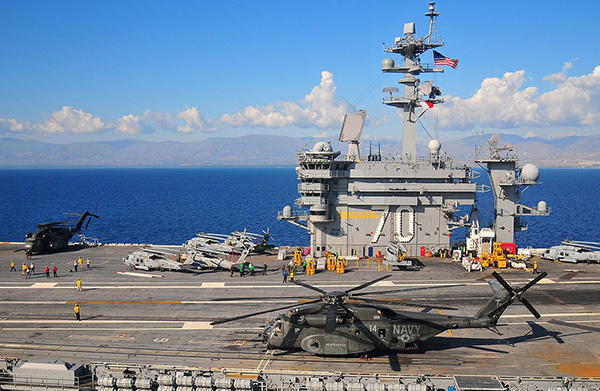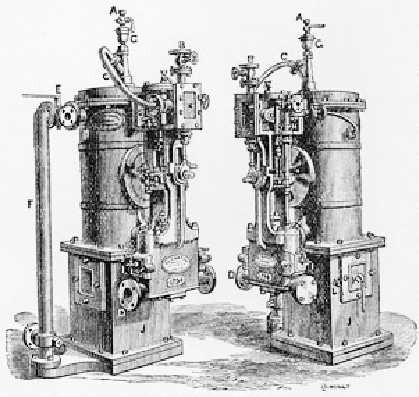
You may remember from an earlier EarthDate that seawater is so salty, drinking it pulls water from the rest of your body, which can lead to dehydration and even death.
To keep their ships stocked with fresh water, sailors have relied on innovation and technology for centuries.
Early on, they realized they could funnel rainwater from their sails into storage—once the rain had washed away the ocean spray.
Greek sailors then discovered they could hang sheep pelts in the cool night air to absorb water vapor, then wring them out in the morning for a wool-flavored drink.
The earliest European sailors used barrels laced with alcohol to keep algae from growing.
Whenever a ship reached land, replenishing its fresh water was usually the most important task.
By the 1700s, inventors had created distillation plants that used a heat source to boil seawater. When it converted to steam, it left the salt behind. The vapor would then condense again into pure distilled water.
Distillers were used until 1980, when they were replaced by reverse-osmosis systems that use membranes to purify and desalinate water.
Today, navy fleets of about 50 ships have the capacity to desalinate more than a million gallons of water a day.
Cities with large naval bases, like San Diego, are looking at ways to use their fleets’ desalination capacity to supplement their municipal water systems in times of drought and other emergencies.
Background
Synopsis: Drinking seawater causes rapid dehydration and death. So, throughout history, how did sailors on long ocean voyages get their fresh water? How are we using these evolving technologies to provide water to our thirsty cities? And how are today’s sailors helping cities even more in times of drought?
- Humans, like other animals, are dependent on fresh water for life.
- If we ingest seawater—about four times as salty as our blood—our kidneys steal fresh water from elsewhere in the body to balance the excess salt, causing thirst, dehydration, and eventually death.
- Sources of fresh water once dictated where humans could live and were often the driving force behind Paleolithic migrations.
- Humans first learned to augment intermittent surface freshwater supplies by digging wells to access fresh groundwater resources.
- The oldest water wells we know of are 10,500-year-old Early Neolithic wells located in Cyprus.
- Today, about 20 percent of water used in the United States comes from groundwater.
- Early seafaring civilizations had to devise ways to carry fresh water with them.
- Refilling freshwater supplies was often the most important task undertaken at every vessel’s landfall.
- Containers ranged from Polynesian bamboo logs to European casks laced with alcohol to prevent algae growth.
- As sea voyages became longer, sailors learned to collect rain from their sails, after rinsing off the salt-spray residue.
- In the 4th century B.C., the Greek philosopher Aristotle noted that “salt water, when it turns into vapour, becomes sweet and the vapour does not form salt water again when it condenses.”
- Greek voyagers often accumulated fresh water by hanging sheep pelts off the sides of ships to collect water vapor while sailing at night, then wringing them out into containers in the morning—a natural distillation process.

Diagram (1883) of Chaplin's patent seawater distilling apparatus, as used for sailing vessels, with steam pump attached for circulating water. Credit: Alexander Chaplin & Co. (public domain)
- By the mid-1700s, ships carried their own desalination plants to remove salts through distillation, creating potable water while at sea.
- The first desalination plant patent was granted in 1869.
- A seawater distillation rig patented by Alexander Chaplin & Co. was excavated from the 1872 wreck of the SS Xantho near Port Gregory, Western Australia, in 1994—probably the only surviving example of this type of maritime device.
- Similar units were adapted into wagons for use on land to supply soldiers with water for desert warfare, such as the campaigns in the Sudan from 1881 to 1899.
- U.S. Navy ships used distillation plants until the 1980s, when less expensive, higher reliability reverse osmosis (RO) plants replaced them.
- These RO plants use thin membranes to filter and desalinate seawater.
- Rapid membrane technology advances continually produce better results.
- Today, more than 17,000 desalination plants produce over 200 billion gallons of fresh water daily in more than 150 countries.
- About half of these plants use salty or brackish groundwater from underground aquifers.
- The other half use seawater—a less attractive option because of the steep costs of energy required to remove the higher concentration of salts from ocean water and the management of toxic residual waste brines left behind.
- Even with desalination plants, coastal cities are still vulnerable to drought, especially in the event of earthquakes or tsunamis. And the U.S. Navy, whose ships regularly provide humanitarian assistance for global disasters, is well-equipped to help out.
- Large coastal cities are often the home of naval bases. For instance, the largest base on the West Coast is in San Diego, the U.S. Navy’s Southwest Region Command Headquarters.
- The base is home to 46 surface ships, including aircraft carriers, destroyers, and cruisers, and 7 submarines, all of which have RO desalination plants. These 53 ships have the capacity to produce more than 1.2 million gallons of water per day while in port.
- The Department of Homeland Security and the U.S. Navy are in the process of working out the permissions and infrastructure to be able to use this ship-board desalination capability, already funded by American taxpayers, to help out coastal cities.
- Other states that could benefit similarly from ships in port include Hawaii, Washington, Connecticut, Georgia, and Virginia.
- Large coastal cities are often the home of naval bases. For instance, the largest base on the West Coast is in San Diego, the U.S. Navy’s Southwest Region Command Headquarters.

